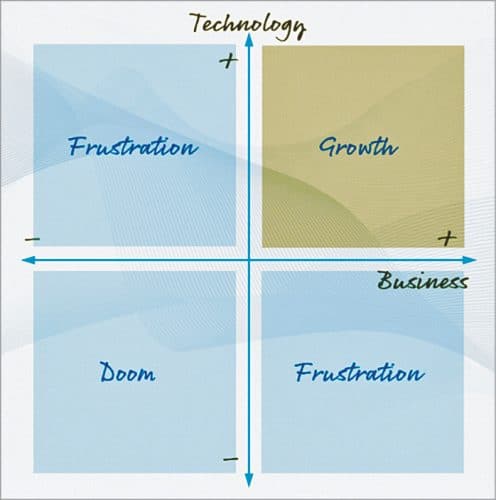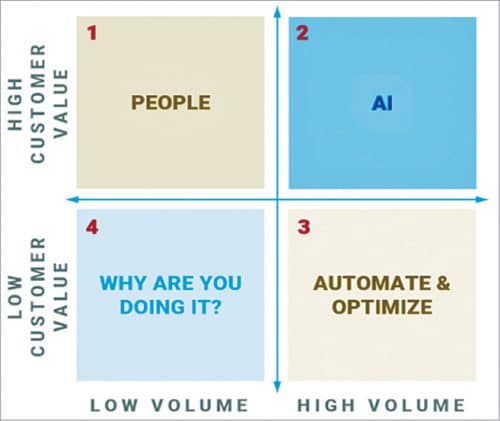The author has worked with over 85+ businesses of various sizes for the last twenty years. In doing so, he has seen a characteristic pattern that differentiates the best from the rest. His Sanity Model here tries to explain it in a more understandable form. In this model, a business must walk the fine line to remain in the safe zone of growth.
The technology-first approach can be a definite way to upset customers. Therefore, the right balance is often necessary for remaining customer-first company.
Many businesses get carried away by the latest smart technology. Tech vendors make them believe that it can be used to solve every problem out there. Emerging technologies are new hammers, avoid treating all the issues as nails.
Deliberate efforts, coupled with thoughtful steps, often yield long-lasting and positive results. The approach is critical because it is quite challenging to undo a strategic or technological mistake these days.
In any organisation, there are two groups. One belongs and subscribes to the management and business aspects of the company. The other favours technological aspects. And often, there is a gap and philosophical differences between these groups.
The tech-tribe often favours solutions, improving efficiency, depends on work-roadmap, wants speed, and needs investment. However, the preference for the business-tribe is to focus on problems. They have a customer-facing approach and want to improve the effectiveness of the business overall. Their preference is for immediate fixes over proper solutions, and they seek profits.
Sanity Model explained
The outcome is growth (the 1st quadrant in Sanity Model) if there is a right balance of business and tech-sense. A business would see consistent and sustainable growth along the sanity line. A slight imbalance usually results in a minor nuisance or shift of focus. However, as long as you are on top of it, it is okay. Understand the need to restore the balance and have a plan to do that.

The exact opposite of this situation is a combination of lousy business-sense and tech-sense, which is undoubtedly a good recipe for doom (the 3rd quadrant).
The other two quadrants represent the lack of either. Either the business has excellent tech-sense but poor business-sense, or it is the opposite. In each case, one tribe is frustrated due to the other. Also, most importantly, the customer, in both cases, would be frustrated and get close to no value from the business’ product or service. Being there for a long time usually pushes the company into the doom quadrant.
We know of several organisations or brands, which we like in general but always wish they used better technologies to serve us (Q4 types). There are also several examples of technology implementations where they did not honour the business aspect. These implementations have either seen an outright failure or have a low yield (Q2 types).
You can pick up any brand you deal with regularly, or know of, and try to put them in this model. You will observe a pattern too.
Here are a few examples
A well-known example of a company that could fit in Q2 (only good tech-sense) would be Nokia. We all loved Nokia phones at one point in time; however, business-sense did not prevail (soon enough) in favour of customers. Unfortunately, this approach pushed the company downwards in Q3, where their technology lagged and eventually became irrelevant.
I recently came across two telecom companies using automated calling systems to persuade customers to buy new plans or switch from their current service provider. Several people have highlighted their frustration and angst with this behaviour of the company. It is a classic example of using technology recklessly and without using proper business sense. Where do you think they fit?
The majority of public sector banks are perhaps the closest examples that could fit in Q4 (they have average business-sense but lag in tech-sense). This outlook may be inherent due to their business’s conservative nature and regulatory frameworks around them. Their tech adoption is slow and often behind general advancements. I know a bank that still has a few systems on DOS in 2021. Banks lacking tech-sense usually get pushed sideways in Q3 of doom. And the ones that at least maintain business-sense stay in Q4 and continue to frustrate us all the time.
Having understood all of this, let me point out three key reasons why your AI program may be at risk.

You are using AI because you have to
Although unlikely, for several organisations this is one of the main reasons for diving into AI in the first place. They are doing it only because everyone else seems to be doing it. Fundamentally, they have not figured out how it fits their strategy or overall business model and operation.
The issue with this approach is, you end up doing something using technology that may not be necessarily useful or impactful. Consider it like buying a new car only because everyone in the neighbourhood has one and you have disposable income. You end up not using it much yet spending time and money on maintenance and upkeep.
This approach puts your AI program at risk due to potential budget run-outs as well as getting into a rabbit hole of technology upkeep. Sooner or later, the endowment effect will kick in, and you will keep investing, just because you have done so much already, despite not seeing any ROI.
I highly recommend getting the answer to “Why you are using AI?” right.
You are using it in the wrong place
The second risk of AI (or any technology) project comes from using it for less impactful or outright meaningless applications. In my experience, it usually comes from vendor advice or so-called best-practice thinking. Just because someone else is doing it, it does not mean you should. However, for a vendor who is selling a solution to your industry, it makes perfect sense. What about you, your people, and your customers? Your decisions must follow that thought process and not what the vendor suggests or advises. Take all the advice you want but getting priorities right is crucial.
Last year, I spoke to some business owners when someone asked me: How to decide when to use technology and when to rely on humans? I managed to put it into a guiding model, as shown in the figure above.
When you deliver something that your customers value the most, but it has a low volume, it is ideal to choose human capital. It will be not only efficient but also empathetic for customers. However, if the need is higher accuracy at higher volume, perhaps AI-like technology is your best bet.
High volume yet low-value activities seem to be good candidates for automation. However, I recommend mix-n-match here. Not all activities need to be automated. There is a cost-benefit tradeoff.
When you use technology in the right place, the benefits are amazing; everywhere else, it can be painful.
Taking humans out of the equation
Full-time employee (FTE) savings often seem too attractive and are often one of the main reasons for taking humans out of the equation. Most technology vendors use FTE savings as one of the leading metrics for highlighting their tech solution’s benefits. However, these benefits are only valid for the remaining financial year, which in most cases can be less than twelve months.
When you start looking at the overall benefit from the customer’s point of view and thereby topline and bottom-line impact, it can often give you a different perspective. My recommendation is not to be hasty when taking humans out of the equation in such cases. Think about the reasons why you put them there in the first place.
Refer back to the earlier model for selecting tech or human capital.
For most businesses, they will never completely go into a dark-factory mode. Dark factories are fully automated, robotic facilities where there are no humans (or maybe a handful of them).
Moreover, it also depends on how you see your brand and business fitting into the whole ecosystem. If you are only profit-centered, anything for profit may look okay. However, if your brand and business stand for the community and the ecosystem around it, the consideration must be different. Taking humans out of the equation, making an extra profit while destroying the community around it is not something you would want to do.
The point is
All the three risks would only result in a waste of funds, not achieving goals, and eventually lagging in the fierce technological race by wasting time. So, to avoid risks:
- Use technology for the right reasons. There is always a better way to achieve the outcome.
- Use technology in the right place. Listen to vendors for their views but follow your internal team’s advice.
- Do not write off your human employees so quickly. Not now, perhaps, never.
Now, I have one question that I would like you to ponder over: What can you do today to be pragmatic and march towards a better future without losing this balance?
Anand Tamboli is a serial entrepreneur, speaker, award-winning published author, and an emerging technology thought leader






